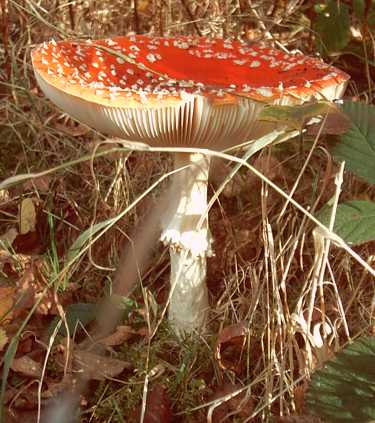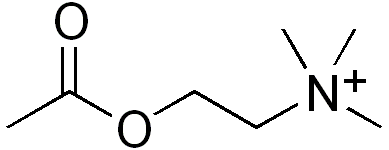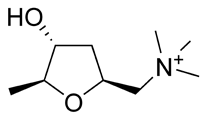Muscarinic acetylcholine receptor
 From Wikidoc - Reading time: 9 min
From Wikidoc - Reading time: 9 min
Editor-In-Chief: C. Michael Gibson, M.S., M.D. [1]




Overview[edit | edit source]
Muscarinic receptors are those membrane-bound acetylcholine receptors that are more sensitive to muscarine than to nicotine. Those for which the contrary is true are known as nicotinic acetylcholine receptors. Muscarine and nicotine are both alkaloids. Many drugs and other substances (for example pilocarpine and scopolamine) act as agonists or antagonists of only muscarinic or only nicotinic receptors, making this distinction useful.
Uses[edit | edit source]
Acetylcholine (ACh) is a neurotransmitter found extensively in the brain and autonomic nervous system. It is also the neurotransmitter used to cause voluntary muscle contraction. Muscarinic receptors are used in the following roles:
Sympathetic and parasympathetic postganglionic: recovery receptors[edit | edit source]
ACh is always used as the transmitter within the autonomic ganglion. Nicotinic receptors on the postganglionic neuron are responsible for the initial fast depolarization (Fast EPSP) of that neuron. As a consequence of this, nicotinic receptors are often cited as the receptor on the postganglionic neurons at the ganglion. However, the subsequent hyperpolarization (IPSP) and slow depolarization (Slow EPSP) which represent the recovery of the postganglionic neuron from stimulation are actually mediated by muscarinic receptors, types M2 and M1 respectively (discussed later).
Presynaptically within the postganglionic neurons[edit | edit source]
Another role for these receptors is at the junction of the innervated tissue and the postganglionic neuron in the parasympathetic division of the autonomic nervous system. Here acetylcholine is again used as a neurotransmitter, and muscarinic receptors form the principal receptors on the innervated tissue. In addition, muscarinic acetylcholine receptors pre-synaptically on the post-ganglionic neuron bind to the released acetylcholine and regulate the response of the postganglionic neuron.
Between the postganglionic neurons and the innervated tissue[edit | edit source]
By contrast, this junction in the sympathetic division does not tend to use acetylcholine as a neurotransmitter (instead, norepinephrine is used), and therefore neither muscarinic nor nicotinic receptors are involved, but rather adrenergic α1 and β1 receptors. A very few parts of the sympathetic system use cholinergic receptors (sweat glands being one of the few exceptions). In these cases, the receptors are of the muscarinic type. The sympathetic nervous system also has single nerves terminating at the chromaffin cells in the adrenal medulla, which secrete epinephrine and norepinephrine into the bloodstream. Acetylcholine is used as a neurotransmitter, and the receptor is of the nicotinic type. The somatic nervous system uses acetylcholine at the junction between its one peripheral nerve and the innervated tissue, also of the nicotinic type.
In the higher central nervous system[edit | edit source]
Muscarinic acetylcholine receptors are also present and distributed throughout the central nervous system, in post-synaptic and pre-synaptic positions. There is also some evidence for postsynaptic receptors on sympathetic neurons allowing the parasympathetic nervous system to inhibit sympathetic effects.
On the presynaptic membrane of the neuromuscular junction[edit | edit source]
It's now known they also appear on the pre-synaptic membrane of somatic neurons in the neuro-muscular junction, where they are involved in the regulation of acetylcholine release.
The Form of Muscarinic Receptors[edit | edit source]
Muscarinic acetylcholine receptors belong to a class of metabotropic receptors which use G proteins as their signalling mechanism. There are known to be a large number of these G-protein-coupled receptors for neuroreceptors, hormones, and other substances. G proteins are also present in taste, and odour detecting cells, in the retina, and in many other systems.
In such receptors, the signalling molecule (the ligand) binds to a receptor which has seven transmembrane regions, in this case the ligand is ACh. This receptor is bound to intracellular proteins, known as G proteins, which begin the information cascade within the cell.
By contrast nicotinic receptors use an ion-gated mechanism for signalling. Sufficient ligands cause an ion channel to open, filling (or evacuating) a cell of a particular ion.
Receptor Isoforms[edit | edit source]
Classification[edit | edit source]
By the use of selective radioactively-labelled agonist and antagonist substances, four subtypes of muscarinic receptors have been determined, named M1-M4 (using an upper case M and subscript number).[1] For example, the drug pirenzepine is a muscarinic antagonist (decreases the effect of ACh) which is much more potent at M1 receptors than it is at other subtypes. The acceptance of the various subtypes has proceeded in numerical order: therefore, sources exist which only recognise the M1/M2 distinction, more recent studies tend to recognise M3, and the most recent M4.
Genetic differences[edit | edit source]
Meanwhile, geneticists and molecular biologists have characterised five genes which appear to encode muscarinic receptors, named m1-m5 (lower case m; no subscript number). The first four code for pharmacologic types M1-M4. The fifth, m5, corresponds to a subtype of receptor which has not been detected pharmacologically. m1 and m2 were determined based upon partial sequencing of M1 and M2 receptor proteins, the others were found by searching for homology, using bioinformatic techniques.
Difference in G proteins[edit | edit source]
Template:Seealso G proteins contain an alpha-subunit which is critical to the functioning of receptors. These subunits can take a number of forms. There are four broad classes of form of G-protein, Gs, Gi, Gq and G12/13.[2] Muscarinic receptors vary in the G protein to which they are bound, with some correlation according to receptor type. G proteins are also classified according to their susceptibility to cholera toxin (CTX) and pertussis toxin (PTX, whooping cough). Gs and some subtypes of Gi (Gαt and Gαg) are succeptible to CTX. Only Gi is succeptible to PTX, with the exception of one subtype of Gi (Gαz) which is immune. Also, only when bound with an agonist, those G proteins normally sensitive to PTX also become susceptible to CTX.[3]
The various G-protein subunits act differently upon secondary messengers, upregulating Phospholipases, downregulating cAMP, and so on.
Because of the strong correlations to muscarinic receptor type, CTX and PTX are useful experimental tools in investigating these receptors.
Comparison of types[edit | edit source]
| Type | Gene | Function | PTX | CTX | Effectors | Agonists[4] | Antagonists[4] |
| M1 | CHRM1 |
|
no (yes) |
no (yes) |
Gq (Gi) (Gs): Slow EPSP. ↓ K+ conductance [5][6] |
||
| M2 | CHRM2 |
|
yes | no | Gi ↑ K+ conductance [5] ↓ Ca2+ conductance [5] |
||
| M3 | CHRM3 |
|
no | no | Gq | ||
| M4 | CHRM4 | yes | ? | Gi ↑ K+ conductance [5] ↓ Ca2+ conductance [5] |
|||
| M5 | CHRM5 |
|
no | ? | Gq |
M1 receptor[edit | edit source]
This receptor is found mediating slow EPSP at the ganglion in the postganglionic nerve,[7] is common in exocrine glands and in the CNS.[8][9]
It is predominantly found bound to G proteins of class Gq[10] which use upregulation of phospholipase C and therefore inositol trisphosphate and intracellular calcium as a signalling pathway. A receptor so bound would not be susceptible to CTX or PTX. However, Gi (causing a downstream decrease in cAMP) and Gs (causing an increase in cAMP) have also been shown to be involved in interactions in certain tissues, and so would be susceptible to PTX and CTX respectively.
M2 receptor[edit | edit source]
The M2 muscarinic receptors are located in the heart, where they act to slow the heart rate down to normal sinus rhythm after stimulatory actions of the sympathetic nervous system, by slowing the speed of depolarization. They also reduce contractile forces of the atrial cardiac muscle, and reduce conduction velocity of the atrioventricular node (AV node). However, they have no effect on the contractile forces of the ventricular muscle.
M2 muscarinic receptors act via a Gi type receptor, which causes a decrease in cAMP in the cell, generally leading to inhibitory-type effects.
M3 receptor[edit | edit source]
M3 receptors are found on smooth muscles, endocrine and in exocrine glands. They generally cause smooth muscle contraction and increased glandular secretions.
The M3 muscarinic receptors are located at many places in the body. They are located in the smooth muscles of the blood vessels, as well as in the lungs. Because the M3 receptor is Gq-coupled and mediates an increase in intracellular calcium, it typically causes constriction of smooth muscle, such as that observed during bronchoconstriction. However, with respect to vasculature, activation of M3 on vascular endothelial cells causes increased synthesis of nitric oxide which diffuses to adjacent vascular smooth muscle cells and causes their relaxation thereby explaining the paradoxical effect of parasympathomimetics on vascular tone and bronchiolar tone. Indeed, direct stimulation of vascular smooth muscle M3 mediates vasconstriction in pathologies whereby the vascular endothelium is disrupted.[11]
The M3 receptors are also located in many glands which help to stimulate secretion in salivary glands and other glands of the body.
Like the M1 muscarinic receptor, M3 receptors are G proteins of class Gq which upregulate phospholipase C and therefore inositol trisphosphate and intracellular calcium as a signalling pathway.
M4 receptor[edit | edit source]
M4 receptors are found in the CNS.
Receptors work via Gi receptors to decrease cAMP in the cell and thus produce generally inhibitory effects.
M5 receptor[edit | edit source]
Location of M5 receptors are not well known.
Like the M1 and M3 muscarinic receptor, M5 receptors are coupled with G proteins of class Gq which upregulate phospholipase C and therefore inositol trisphosphate and intracellular calcium as a signalling pathway.
See also[edit | edit source]
References[edit | edit source]
- ↑ Caulfield MP, Birdsall NJ (1998). "International Union of Pharmacology. XVII. Classification of muscarinic acetylcholine receptors". Pharmacol. Rev. 50 (2): 279–90. PMID 9647869.
- ↑ Simon MI, Strathmann MP, Gautam N (1991). "Diversity of G proteins in signal transduction". Science. 252 (5007): 802–8. doi:10.1126/science.1902986. PMID 1902986.
- ↑ Dell'Acqua ML, Carroll RC, Peralta EG (1993). "Transfected m2 muscarinic acetylcholine receptors couple to G alpha i2 and G alpha i3 in Chinese hamster ovary cells. Activation and desensitization of the phospholipase C signaling pathway". J. Biol. Chem. 268 (8): 5676–85. PMID 8449930.
- ↑ 4.0 4.1 Tripathi KD (2004). Essentials of Medical Pharmacology (5th ed.). India: Jaypee Brothers, Medical Publishers. pp. 890 pages. ISBN 81-8061-187-6. if nothing else mentioned in table
- ↑ 5.00 5.01 5.02 5.03 5.04 5.05 5.06 5.07 5.08 5.09 5.10 5.11 5.12 5.13 5.14 5.15 5.16 5.17 5.18 5.19 5.20 5.21 5.22 5.23 5.24 5.25 5.26 5.27 5.28 5.29 5.30 5.31 5.32 5.33 5.34 5.35 5.36 5.37 5.38 5.39 5.40 5.41 5.42 5.43 Rang HP, Dale MM, Ritter JM, Moore PK (2003). "Ch. 10". Pharmacology (5th edition ed.). Elsevier Churchill Livingstone. pp. page 139. ISBN 0-443-07145-4.
- ↑ PUBMED - Muscarine reduces inwardly rectifying potassium conductance in rat ...
- ↑ Messer, Jr, WS (2000-01-20). "Acetylcholine". University of Toledo. Retrieved 2007-10-27.
- ↑ Johnson, Gordon (2002). PDQ Pharmacology (2nd ed. ed.). Hamilton, Ontario: BC Decker Inc. pp. 311 pages. ISBN 1-55009-109-3.
- ↑ Richelson, Elliott (2000). "Cholinergic Transduction, Psychopharmacology - The Fourth Generation of Progress". American College of Neuropsychopharmacology. Retrieved 2007-10-27.
- ↑ Burford NT, Nahorski SR (1996). "Muscarinic m1 receptor-stimulated adenylate cyclase activity in Chinese hamster ovary cells is mediated by Gs alpha and is not a consequence of phosphoinositidase C activation". Biochem. J. 315 ( Pt 3): 883–8. PMID 8645172.
- ↑ Keith Parker; Laurence Brunton; Goodman, Louis Sanford; Lazo, John S.; Gilman, Alfred (2006). Goodman & Gilman's the pharmacological basis of therapeutics (11th Ed. ed.). New York: McGraw-Hill. pp. page 185. ISBN 0-07-142280-3.
External links[edit | edit source]
- IUPHAR GPCR Database - Muscarinic Acetylcholine Receptors
- Receptors,+Muscarinic at the US National Library of Medicine Medical Subject Headings (MeSH)
de:Muskarinischer Acetylcholinrezeptor uk:Мускариновий ацетилхоліновий рецептор
 KSF
KSF